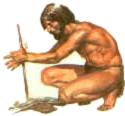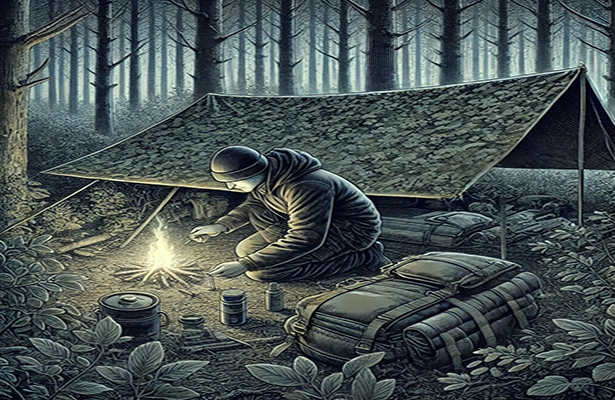Survival Skills for Starting a Fire in Any Condition
Building a fire without matches can seem daunting, but with a little knowledge and practice, it can be an essential survival skill. Here are the steps to building a fire without matches:
-
Gather your materials: You’ll need dry tinder, kindling, and fuel wood. Tinder is small, dry materials that catch fire easily, such as dry grass or leaves. Kindling is small sticks and twigs that will burn longer than the tinder. Fuel wood is larger logs that will keep the fire burning for a longer period of time.
-
Choose your fire-starting method: There are several fire-starting methods to choose from, including the bow drill, hand drill, fire plow, and fire piston. Each method requires different materials and techniques, so choose the method that works best for your situation and skill level.
-
Prepare your fire-starting tools: Depending on your method, you may need a bow and drill, a knife, a fire plow board, or a fire piston. Make sure your tools are in good condition and functioning properly before starting your fire.
-
Start your fire: Once you have your materials, fire-starting method, and tools ready, it’s time to start your fire. Begin by creating a small pile of tinder, and use your fire-starting method to create heat and ignite the tinder. Blow gently on the fire to encourage it to grow, and slowly add kindling and fuel wood as needed.
-
Maintain your fire: Once your fire is burning, it’s important to maintain it properly. Keep adding fuel wood as needed, and use a stick or shovel to move the wood around and keep the fire burning evenly. Make sure to keep a safe distance from the fire and never leave it unattended.
Building a fire without matches can be a challenging and rewarding experience. With practice and patience, it can become an essential survival skill that can keep you warm and safe in the great outdoors.
Building a fire with a bow is a traditional method of starting a fire that has been used for thousands of years. It requires some practice and patience, but with the right materials and technique, it can be a reliable way to start a fire in the wilderness. Here are the steps to building a fire with a bow:


-
Gather your materials: You will need a bow, a drill, a fire board, and some tinder. The bow should be sturdy and flexible, and the string should be made from a strong, non-stretchy material like paracord. The drill should be straight and about the thickness of your thumb, and the fire board should be a dry, flat piece of wood.
-
Prepare the fire board: Cut a small notch in the center of the fire board, and carve a groove leading from the notch to the edge of the board. This will create a channel for the dust and heat to build up and ignite the tinder.
-
Tie the string to the bow: Tie the string to the bow so that it is taut when the bow is bent. You will use the bow to rotate the drill and create friction with the fire board.
-
Prepare the drill: Place the drill in the notch on the fire board, and hold it firmly with one hand. Use your other hand to rotate the drill back and forth rapidly, using the bow to help generate the motion.
-
Build up heat: As you rotate the drill, the friction will create heat and dust in the groove of the fire board. Continue to rotate the drill until you see smoke or dust start to build up in the notch.
-
Ignite the tinder: Once you see smoke or dust, stop rotating the drill and gently blow on the dust to ignite it. Add small twigs and other kindling to the fire as it starts to grow.
Building a fire with a bow can take some practice, but it is a valuable skill to have in the wilderness. With the right materials and technique, you can use this traditional method to start a fire without matches or a lighter. Remember to always practice fire safety and be cautious when building fires in the great outdoors.
Building a fire by friction rubbing sticks is an ancient skill that has been used by humans for thousands of years. It requires patience, practice, and the right materials. Here are the steps to building a fire by friction:


-
Gather your materials: You will need a fireboard, a spindle, a handhold, and tinder. The fireboard should be a piece of dry, flat wood, while the spindle and handhold can be made from any dry, straight stick. The tinder can be anything that catches fire easily, such as dry leaves or grass.
-
Prepare the fireboard: Cut a small notch near the edge of the fireboard. This will be where the dust from the spindle will collect and ignite.
-
Start the spindle: Place the spindle in the notch on the fireboard and use your handhold to apply downward pressure. Begin to spin the spindle back and forth rapidly. The friction created by the spinning will heat up the spindle and the fireboard.
-
Collect the dust: As the spindle heats up, it will begin to produce a fine black dust. This dust will collect in the notch of the fireboard.
-
Ignite the tinder: Keep spinning the spindle until the dust in the notch begins to smolder. Blow gently on the dust to help it catch fire. Place the burning tinder onto your prepared campfire fuel and blow on it gently to get the fire going.
Building a fire by friction is a challenging and rewarding skill to master. It requires practice and patience, but once you have learned the technique, you will be able to build a fire in almost any situation. Remember to always practice fire safety and be cautious when building fires in the great outdoors.
A fire plow is a tool that can be used to create friction and generate heat, which can then be used to start a fire. Here are the steps to use a fire plow:

- Choose a dry, soft wood for the fire plow and a harder wood for the fire board.
- Cut a groove in the fire board, running perpendicular to the length of the board. The groove should be about half an inch wide and a few inches long.
- Use the fire plow to create friction in the groove of the fire board. To do this, hold the fire plow with both hands and rub it back and forth along the groove in the fire board. Apply downward pressure on the fire plow and maintain a consistent speed and pressure.
- As you continue to rub the fire plow in the groove, you will start to generate heat and create a small pile of wood dust at the end of the groove.
- Once you have a pile of wood dust, carefully transfer it to a small pile of kindling or dry leaves, and gently blow on it to create a flame.
- As the flame grows, gradually add larger pieces of wood to the fire, making sure to keep the flame fed with enough oxygen to continue burning.
Remember that creating fire with a fire plow takes time and practice. Be patient, and keep trying until you achieve success.
A fire piston is a tool used for starting a fire using the principles of compressed air. It works by compressing air inside a cylinder, which heats the air up to the point where it ignites a piece of tinder. Here are the steps to building a fire with a fire piston:

-
Gather your materials: You will need a fire piston, a piece of tinder, and some kindling. The fire piston consists of a cylinder and a plunger, and can be purchased at outdoor supply stores or online.
-
Prepare the tinder: Choose a piece of dry, fibrous material for your tinder. Good choices include cotton balls, char cloth, or birch bark. Place the tinder inside the end of the fire piston.
-
Compress the air: Place the plunger inside the cylinder and push it down quickly and firmly. This compresses the air inside the cylinder, which causes it to heat up rapidly. After a few seconds, the heat generated by the compressed air should be enough to ignite the tinder.
-
Light the kindling: Once the tinder has ignited, place it inside your kindling and gently blow on it to help it catch fire. Add more kindling as needed until you have a good-sized fire.
Using a fire piston can be an effective way to start a fire in the wilderness, but it does require some practice and skill. Be sure to choose the right materials for your tinder and kindling, and take care not to damage your fire piston during use. Always practice fire safety and be cautious when building fires in the great outdoors.

20.8 lb. Stealth Camping Bag? A complete Guide to Stealth Camping
Stealth camping can be a thrilling and adventurous way to experience the outdoors, but it requires careful planning and preparation. One of the most important […]






